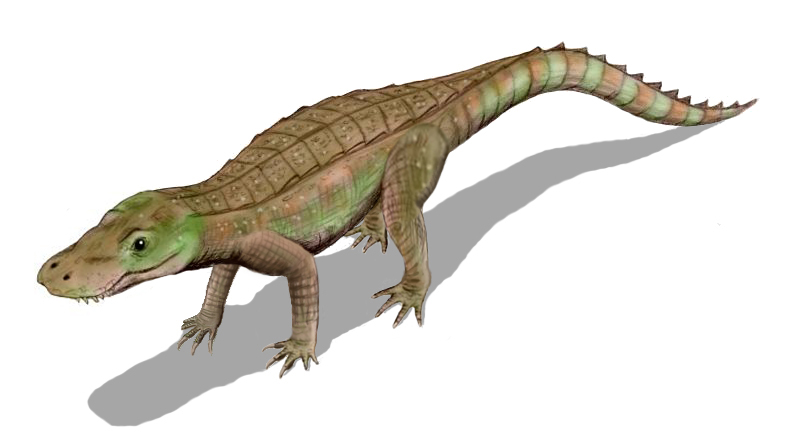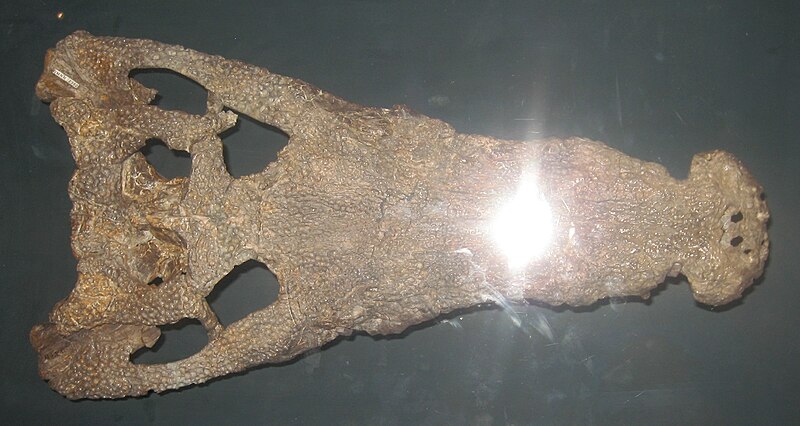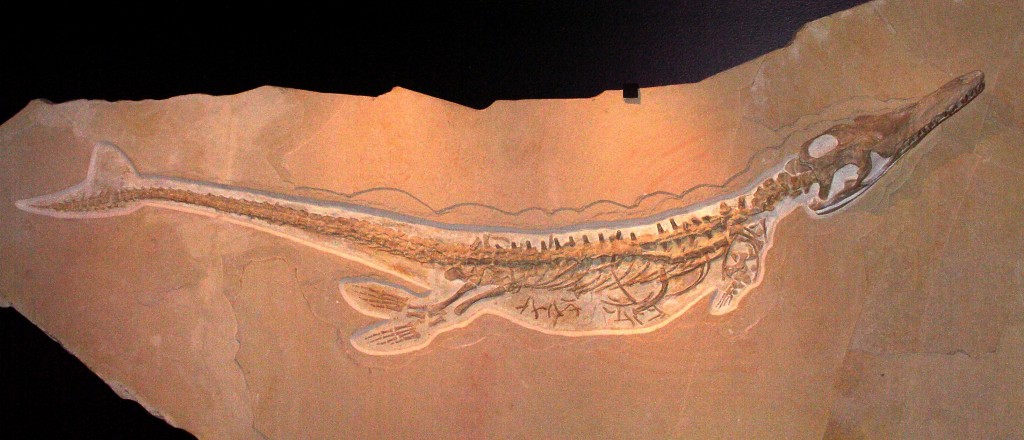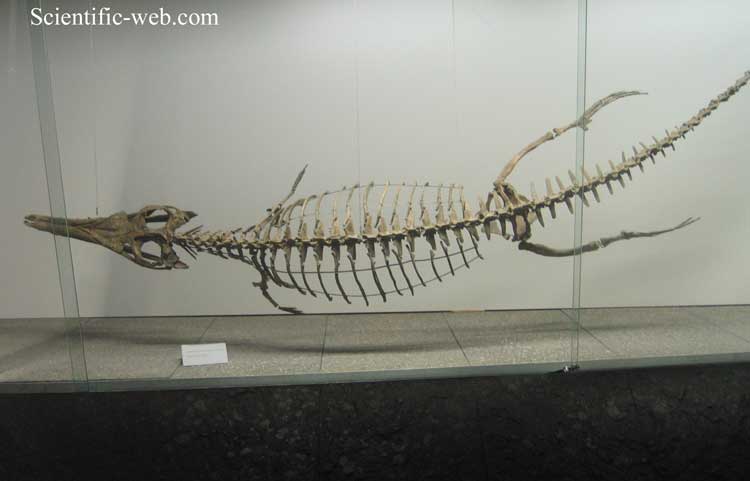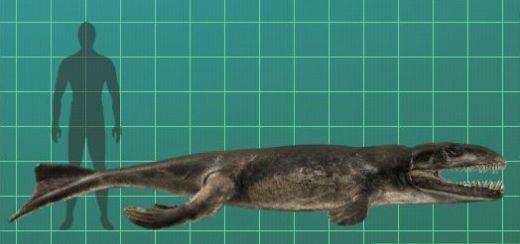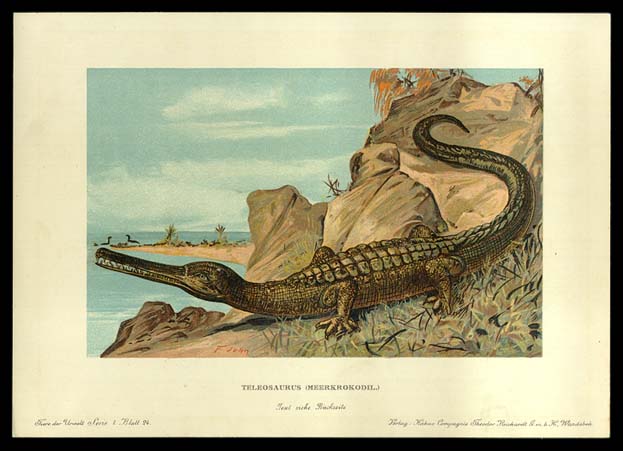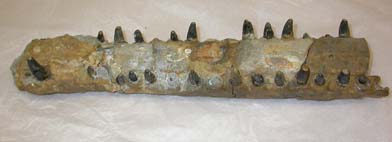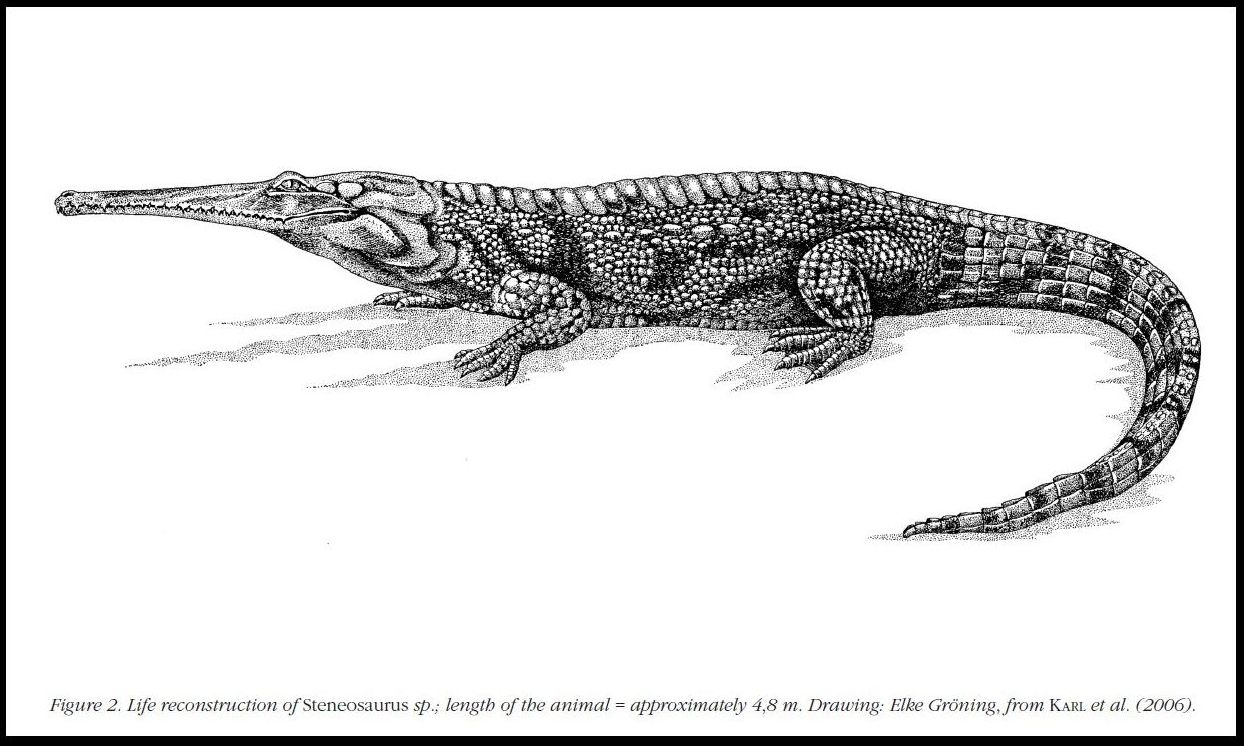[Recent Entries][Archive][Friends][User Info]
Below are 15 entries, after skipping 40 most recent ones in the "Сообщество, посвящённое ра" journal:| February 16th, 2014 | |
|---|---|
| 02:18 pm [industrialterro] [Link] |
Anatosuchus Anatosuchus ("duck crocodile", for the broad, duck-like snout) is an extinct genus of notosuchian crocodylomorph discovered in Gadoufaoua, Niger, and described by a team of palaeontologists led by the American Paul Sereno in 2003, in the Journal of Vertebrate Paleontology. Its duck-like snout coincidentally makes it resemble a crocoduck. The type species of Anatosuchus is A. minor, in reference to its small body size. The holotype material (MNN GDF603), is a nearly complete skull with articulated lower jaws. It was discovered from the upper portion of the Elrhaz Formation and lower portion of Echkar Formation, indicating an Early Cretaceous (Late Aptian or Early Albian). In the initial description of Anatosuchus, it formed a clade with Comahuesuchus, within a less inclusve Notosuchia, also found to be monophyletic. However, further work proposed that Anatosuchus is not closely related to Comahuesuchus. As the specific name indicates, A. minor was a very small crocodylomorph, with an adult body length estimated at around 70 centimeters. It had a very broad, duck-like snout.
Tags: Вымершие рептилии, Мел, архозавроморфы, архозавры, диапсиды, крокодиломорфы, круротарзы, мезоэукрокодилии, нотозухии, равизухии |
| 01:31 pm [industrialterro] [Link] |
Adamantinasuchus Adamantinasuchus is an extinct genus of notosuchian crocodylomorph from the Late Cretaceous of Brazil. Ziphosuchia is a clade of mesoeucrocodylian crocodyliforms that includes notosuchians and sebecosuchians. First constructed in 2000, it was considered to include Notosuchus, Libycosuchus, and Sebecosuchia. In a 2004 phylogenetic study, it was defined as the most recent common ancestor of Notosuchus, Libycosuchus, and Baurusuchoidea and all of its descendants. Ziphosuchia is often considered to be the sister group of Neosuchia, a clade that includes modern crocodilians. Because the fossil range of Neosuchia extends back to the Early Jurassic with the family Goniopholididae, a ghost lineage of ziphosuchians dating back to that divergence point can be expected. Notosuchia is a suborder of primarily Gondwanan mesoeucrocodylian crocodylomorphs that lived during the Cretaceous. Fossils have been found from South America, Africa, Asia, and Europe. Notosuchia was a clade of terrestrial crocodilians that evolved a range of feeding behaviours, including herbivory (Chimaerasuchus), omnivory (Simosuchus), and terrestrial hypercarnivory (Baurusuchus). It included many members with highly derived traits unusual for crocodylomorphs, including mammal-like teeth, flexible bands of shield-like body armor similar to those of armadillos (Armadillosuchus), and possibly fleshy cheeks and pig-like snouts (Notosuchus). The suborder was first named in 1971 by Zulma Gasparini and has since undergone many phylogenetic revisions. Notosuchians were generally small, with slender bodies and erect limbs. The most distinctive characteristics are usually seen in the skull. Notosuchian skulls are generally short and deep. While most are relatively narrow, some are very broad. Simosuchus has a broadened skull and jaw that resembles a pug, while Anatosuchus has a broad, flat snout like that of a duck. The teeth vary greatly between different genera. Many have heterodont dentitions that vary in shape across the jaw. Often, there are large canine-like teeth protruding from the front of the mouth and broader molar-like teeth in the back. Some genera, such as Yacarerani and Pakasuchus, have extremely mammal-like teeth. Their molars are complex and multicuspid, and are able to occlude or fit with one another. Some forms such as Malawisuchus had jaw joints that enabled them to move the jaw back and forth in a shearing motion rather than just up and down. A derived group of notosuchians, the baurusuchids, differ considerably from other forms. They are very large in comparison to other notosuchians and are exclusively carnivorous. Baurusuchids have deep skulls and prominent canine-like teeth. The clade Notosuchia has undergone many recent phylogenetic revisions. In 2000, Notosuchia was proposed to be one of two groups within the clade Ziphosuchia, the other being Sebecosuchia, which included deep snouted forms such as baurusuchids and sebecids. The definition of Notosuchia by Sereno et al. (2001) is similar to that of Ziphosuchia as it includes within it Sebecosuchia. Pol (2003) also includes Sebecosuchia within Notosuchia. More recently, a phylogenetic analysis by Larsson and Sues (2007) resulted in the naming of a new clade, Sebecia, to include sebecids and peirosaurids. Baurusuchidae was considered to be polyphyletic in this study, with Pabwehshi being a basal member of Sebecia and Baurusuchus being the sister taxon to the clade containing Neosuchia and Sebecia. Thus, Sebecosuchia was no longer within Notosuchia and not considered to be a true clade, while Notosuchia was found to be a basal clade of Metasuchia.
Tags: Вымершие рептилии, Мел, архозавроморфы, архозавры, диапсиды, зифозухии, крокодиломорфы, круротарзы, мезоэукрокодилии, нотозухии, равизухии |
| May 3rd, 2012 | |
| 07:57 pm [industrialterro] [Link] |
Goniopholis Goniopholis is an extinct genus of crocodyliform that lived in North America, Europe and Asia during the Late Jurassic and Early Cretaceous. Being semi-aquatic it is very similar to modern crocodiles. It ranged from 2–4 metres in length, and would have had a very similar lifestyle to the American alligator or Nile crocodile. Goniopholis was closely related to the ancestor of extant crocodilians. Many species of Goniopholis have been described, G. crassidens lived during the Early Cretaceous (Berriasian) of England. Goniopholis simus is from the Early Cretaceous of NW Germany; G. gilmorei and G. stovalli are from the Late Jurassic of North America, while G. baryglyphaeus is known from the Late Jurassic (Kimmeridgian) of Portugal making it the oldest known Goniopholis species. Other Late Jurassic species such as, G. phuwiangensis is known from NE Thailand, and G. lucasii from the Tithonian of Colorado (although may belong to a different genus, Amphicotylus). Nannosuchus gracilidens from the Early Cretaceous of England is a juvenile Goniopholis. The species G. kiplingi is named for the author Rudyard Kipling, "in recognition for his enthusiasm for natural sciences. На знаменитом Юрском побережье Британии палеонтологи нашли прекрасно сохранившийся череп ископаемого крокодила. Назвать древнюю рептилию решили в честь писателя Редьярда Киплинга. Окаменевший череп размером около метра принадлежал крокодилу Goniopholis kiplingi, имевшему общую длину порядка 3,5 метра. По мнению палеонтологов Бристольского университета, гониофолис киплинги может считаться предком современных морских крокодилов. Рептилия питалась рыбами, черепахами и другими обитателями теплых тропических болот и лагун, располагавшихся на месте современного британского графства Дорсет 130 миллионов лет назад, в начале мелового периода. Как рассказал профессор Майкл Бентон, череп крокодила оказался очень интересным образцом. "Он не раздавлен, он находится в хорошем состоянии, и он принадлежит новому виду", – сообщил ученый. Видовое название находке решено было дать в честь английского писателя, нобелевского лауреата Редьярда Киплинга, известного своим увлечением естественными науками. Род Goniopholis был известен палеонтологам и раньше, отмечает The Guardian, первые его представители были найдены в Англии более века назад. Новый вид отличается от уже известных более крупными костями черепа и особенностями строения верхней челюсти. По словам обнаружившего окаменелость менеджера геологической службы Юрского побережья Ричарда Эдмонтса, ему просто фантастически повезло с находкой. Торчащий из породы череп он нашел в ходе обычного мониторинга прибрежной эрозии. "Это было невероятной удачей. Камни в месте находки должны были обрушиться меньше чем через неделю после того, как я прошел там", – сообщил он. "Самое интересное, что летопись окаменелостей еще далеко не полна. Мы многое знаем о наиболее распространенных окаменелостях, но из живших когда-то животных окаменевают столь немногие, что у нас всегда остается перспектива найти новые виды, – рассказал Эдмондс, в честь которого назван один вид небольших вымерших омаров. – Карабкаться по скалам никогда не было хорошей идеей, и стучать молотком по случайному месту в скале бессмысленно. Зато пляжи являются лучшими местами для поиска окаменелостей. Скалы здесь невероятно мягкие и оползни размываются очень быстро, так что обычно вы можете подобрать красивые ископаемые, которые просто лежат на пляже. Даже через 200 лет люди будут делать новые открытия, вероятно, с той же скоростью, что и мы сегодня".
Ископаемые останки (1, 2, 3, 4, 5):
Tags: Вымершие рептилии, Юра, архозавроморфы, архозавры, гониофолидиды, диапсиды, крокодиломорфы, круротарзы, мезоэукрокодилии, неозухии, равизухии |
| 07:34 pm [industrialterro] [Link] |
Cricosaurus Cricosaurus is an extinct genus of marine crocodyliform belonging to the family Metriorhynchidae. The genus was established by Johann Andreas Wagner in 1858 for three skulls from the Tithonian (Late Jurassic) of Germany. The name Cricosaurus means "Ring lizard", and is derived from the Greek Cricos- ("ring") and σαῦρος -sauros ("lizard"). Fossil specimens referrable to Cricosaurus are known from Late Jurassic deposits in England, France, Switzerland, Germany, Argentina, Cuba, and Mexico. Cricosaurus was first named by Wagner in 1858, as a re-classification of a specimen he had previously described in 1852. Several other species have since been named, including C. suevicus by Fraas in 1901 (originally as a species of Geosaurus. One former species, C. medius (named by Wagner in 1858) has since been reclassified as a junior synonym of Rhacheosaurus gracilis. The original three skulls (all assigned to different species) were poorly known, and the genus had been considered a junior synonym of Metriorhynchus, Geosaurus or Dakosaurus by different palaeontologists in the past. Some phylogenetic analysis did not support the monophyly of Cricosaurus, However, a more comprehensive analysis in 2009 showed that the species contained in Cricosaurus were valid, and furthermore that several long-snouted species formerly classified in the related genera Geosaurus, Enaliosuchus and Metriorhynchus were in fact more closely related to the original specimens of Cricosaurus, and thus were re-classified into this genus. All currently known species would have been three metres or less in length. When compared to living crocodilians, Cricosaurus can be considered moderate to small-sized. Its body was streamlined for greater hydrodynamic efficiency, which along with its finned tail made it a more efficient swimmer than modern crocodilian species. Recent examination of the fossil specimens of Cricosaurus araucanensis have shown that both juveniles and adults of this species had well-developed salt glands. This means that it would have been able to "drink" salt-water from birth (necessary for a pelagic animal) and eat prey that have the same ionic concentration as the surrounding sea water (i.e. cephalopods) without dehydrating. Adult specimens of Metriorhynchus also have these well-developed salt glands. Several species of metriorhynchids are known from the Mörnsheim Formation (Solnhofen limestone, early Tithonian) of Bavaria, Germany: Dakosaurus maximus, Geosaurus giganteus, Cricosaurus suevicus and Rhacheosaurus gracilis. It has been hypothesised that niche partitioning enabled several species of crocodyliforms to co-exist. The top predators of this Formation appear to be Dakosaurus and G. giganteus, which were large, short-snouted species with serrated teeth. The long-snouted Cricosaurus species would have feed mostly on fish, although the more lightly built Rhacheosaurus may have specialised towards feeding on small prey. In addition to these four species of metriorhynchids, a moderate-sized species of Steneosaurus was also contemporaneous. From the slightly older Nusplingen Plattenkalk (late Kimmeridgian) of southern Germany, both C. suevicus and Dakosaurus maximus are contemporaneous. As with Solnhofen, C. suevicus feed upon fish, while D. maximus was the top predator.
Ископаемые останки (1, 2, 3, 4):
Tags: Вымершие рептилии, Юра, архозавроморфы, архозавры, диапсиды, крокодиломорфы, круротарзы, мезоэукрокодилии, метриоринхиды, равизухии, талаттозухии |
| 06:51 pm [industrialterro] [Link] |
Metriorhynchus Metriorhynchus is an extinct genus of marine crocodyliform that lived in the oceans during the Middle to Late Jurassic. Metriorhynchus was named by the German palaeontologist Christian von Meyer in 1830. Metriorhynchus was a carnivore that spent much, if not all, its life out at sea. No Metriorhynchus eggs or nests have been discovered, so little is known of the reptile's lifecycle, unlike other large marine reptiles of the Mesozoic, such as plesiosaurs or ichthyosaurs which are known to give birth to live young out at sea. Where Metriorhynchus mated, whether on land or at sea, is currently unknown. The name Metriorhynchus means "Moderate snout", and is derived from the Greek Metrio- ("moderate") and -rhynchos ("snout"). Fossil specimens referrable to Metriorhynchus are known from Middle-Late Jurassic deposits of England, France and Germany. Species in this genus are traditionally classed into two skull groups: longirostrine (long, narrow jaws) and brevirostrine (short, broad jaws). However there has been some contention as to how many of these species are valid, especially those from the Callovian. All brevirostrine species have been transferred to the genera: Purranisaurus and Suchodus. Eudes-Deslongchamps (1867–69) found there to be four Callovian species: M. superciliosus, M. moreli, M. blainvillei, and M. brachyrhynchus. Andrews (1913) considered there to be seven valid species: M. superciliosus, M. moreli, M. brachyrhynchus, M. durobrivensis, M. cultridens, M. leedsi and M. laeve. Adams-Tresman (1987) using linear morphometrics however could only distinguish between the two skull groups, so she found there to be two species: M. superciliosus and M. brachyrhynchus. Vignaud (1997) however, considered there to be three Callovian species: M. superciliosus, M. brachyrhynchus and M. leedsi. M. superciliosus: Western Europe (England, France and Germany) of the Middle-Late Jurassic (Callovian and Oxfordian); M. moreli, M. blainvillei, and M. jaekeli are junior synonyms. M. hastifer: Western Europe (France) of the Late Jurassic (Kimmeridgian) M. geoffroyii: (type species) Western Europe (England, France and Switzerland) of the Late Jurassic (Kimmeridgian); M. palpebrosus, and M. temporalis are junior synonyms. Two longirsotrine species, M. acutus and M. leedsi have been referred to the genus Gracilineustes. Fragmentary remains of Metriorhynchus are known from South America during the Bajocian and Bathonian (both Middle Jurassic). However, phylogenetic analysis has shown neither of these species can be referred to Metriorhynchus. The genera Purranisaurus and Suchodus have been considered junior synonyms of Metriorhynchus, Recent phylogenetic analyses however, do not support the monophyly of Metriorhynchus. Some of the longirostrine forms, however, do appear to form a natural group. The cladogram presented below follows an analysis by Mark Young and Marco Brandalise de Andrade, published in November 2009. Averaging 3 metres (9.8 ft) in length, Metriorhynchus was of a similar size to modern crocodiles. However, it had a streamlined body and a finned tail, making it a more efficient swimmer than modern crocodilian species. Recent examination of the fossil specimens of Metriorhynchus superciliosus, have shown that adults of this species had well-developed salt glands. This means that like Geosaurus it would have been able to "drink" salt-water (necessary for a pelagic animal) and eat prey that have the same ionic concentration as the surrounding sea water (i.e. cephalopods) without dehydrating. Metriorhynchus was a versatile and opportunistic predator, predated upon both the armoured belemnites, fast moving fish and the giant filter feeding fish Leedsichthys. Occasionally it was also capable of capturing flying animals such as the pterosaurs and scavenging on plesiosaur carcasses on the seafloor. Even though Metriorhynchus was an effective predator, it was vulnerable to predation from apex predators such as Liopleurodon which could grow in excess of 10 meters in length. Since Metriorhynchus had lost its osteoderms, "Armour scutes", to become more efficient swimmers it would have had little defense against larger marine predators.
Репродукции (1, 2, 3, 4, 5, 6, 7, 8):
( Далее ) Ископаемые останки (1, 2, 3, 4, 5):
Tags: Вымершие рептилии, Юра, архозавроморфы, архозавры, диапсиды, крокодиломорфы, круротарзы, мезоэукрокодилии, метриоринхиды, равизухии, талаттозухии |
| May 1st, 2012 | |
| 04:09 pm [industrialterro] [Link] |
Dakosaurus Дакозавры (Dakosaurus) — морские крокодилы позднеюрской-раннемеловой эпохи. Относятся к так называемым «морским крокодилам» — семейству Metriorhynchidae. Это единственные полностью морские архозавры. Одни из немногих метриоринхид, приспособленных почти исключительно к охоте на крупную добычу. Описаны Ф. Квенштедтом в 1856 году, долгое время были известены по отдельным зубам из юрских отложений Западной Европы. Синонимы — Dacosaurus, Ltliminosaurus, Neustosaurus, Plesiosuchus. Brachytaenius perennis. Были описаны Г. фон Мейером еще в 1842 году, но название признано невалидным. В настоящее время признано 6—7 видов: Dakosaurus maximus (Quenstedt, 1856) — типовой вид. Известен из позднего киммериджа — раннего титона Англии, Франции, Швейцарии и Германии. Описан из Германии. Известен полный скелет около 6 метров длиной. Череп изображается относительно низким, но в реальности плохо известен. Более вероятно, что череп по очертаниям напоминал череп Dakosaurus andiniensis. Dakosaurus paradoxus (Wagner, 1853) — описан по зубам из поздней юры Германии. Dakosaurus primaeuvs (Sauvage, 1871) — зубы из поздней юры Франции. Dakosaurus lapparenti (Deblemas & Strannoloubsky, 1957) — зубы из раннего мела (валанжин) Франции. Dakosaurus andiniensis (Vignaud & Gasparini, 1996) — из поздней юры — раннего мела (титон — берриас) Аргентины. Открыт в Неквенском бассейне в 1987 году, первоначально считался видом метриоринха. Описан в 1996 году. В 2006 году был найден полный череп этого вида, показавший его крайнюю специализацию к охоте на крупную добычу. В средствах массовой информации вид получил прозвище «Годзилла». Длина животного была около 4 метров. Его череп разительно похож на черепа наземных хищных динозавров, что предполагает образ жизни крупного хищника/падальщика. В 2007 году останки дакозавра обнаружены в киммеридже Мексики. Dakosaurus carpenteri (Wilkinson et al., 2008) — примитивный вид, чрезвычайно сходный с короткомордыми метриоринхами. Описан в 2008 году из киммериджа Англии. Крупное животное (череп до 1 метра длиной, общая длина до 6 метров). Морда короткая, спереди закругленная, череп высокий, зубы огромные, немногочисленные, зифодонтные (как у хищных динозавров). Глазницы крупные, со склеральным кольцом. Имеется предглазничное окно, вероятно, вмещавшее солевую железу. Сверху предглазничное окно прикрыто выростами черепа. Конечности преобразованы в ласты, особенно передние. Передние ласты значительно короче задних. Конец хвоста изогнут вниз и служил основой для хвостового плавника, сходного с таковым ихтиозавров. Панцирь редуцирован. По образу жизни дакозавры (особенно Dakosaurus andiniensis) могли напоминать китов-косаток. Интересно, что большинство видов делило море с крупными плиозаврами. Возможно, дакозавры были в большей степени падальщиками. Неизвестно, каким способом размножались морские крокодилы. Судя по всему, они должны были откладывать яйца (яйца крокодилов одеты твердой скорлупой и живородящих видов среди современных крокодилов нет). Для этого надо выходить на сушу. Возможно, именно эта особенность ограничила их размеры (среди метриоринхид нет гигантских видов) и привела в итоге к вымиранию группы в начале среднего мела. В конце эры морских крокодилов в начале и середине мелового периода, там существовал и свой «суперхищник» - дакозавр, прозванный «годзиллой» океана, за крайне необычное устройство своего черепа. Способ охоты дакозавров точно не известен - такой короткий череп очень сильно неудобен для охоты на верткую рыбу, из-за невозможности быстро сомкнуть пасть (мешает сопротивление воды). Как предполагается, дакозавры охотились на крупную добычу - ихтиозавров и морских плезиозавров небольшого размера, подкаралуливая их в засаде и быстро набрасываясь на них, вырывая из жертв большие куски мяса. Как считается, именно эти крокодилы вызвали быстрое сокращение видового разнообразия в рамках данных отрядов морских ящеров. Однако, что привело к неожиданному исчезновению самих дакозавров и их ближайших родственников геозавров – неизвестно. Возможно, сильную конкуренцию им составили новые ящеры моря – вараноиды мозазавры, быстро захватившие титул суперхищников океанов в середине мела.
Репродукции (1, 2, 3, 4, 5, 6, 7, 8, 9):
( Далее ) Размеры тела в сравнении с человеком:
Ископаемые останки (1, 2, 3, 4, 5):
Tags: Вымершие рептилии, Юра, архозавроморфы, архозавры, диапсиды, крокодиломорфы, круротарзы, мезоэукрокодилии, метриоринхиды, равизухии, талаттозухии |
| 03:46 pm [industrialterro] [Link] |
Geosaurus Geosaurus is an extinct genus of marine crocodyliform within the family Metriorhynchidae that lived during the Late Jurassic to the Early Cretaceous. Geosaurus was a carnivore that spent much, if not all, its life out at sea. No Geosaurus eggs or nests have been discovered, so little is known of the reptile's lifecycle, unlike other large marine reptiles of the Mesozoic, such as plesiosaurs or ichthyosaurs which are known to give birth to live young out at sea. Where Geosaurus mated, whether on land or at sea, is currently unknown. The name Geosaurus means "Earth lizard", and is derived from the Greek Ge- ("Earth") and σαῦρος -sauros ("lizard"). The name Geosaurus was established by the French naturalist Georges Cuvier in 1824. The modern Chinese term for Geosaurus is Dilong 地龍 "earth dragon" (地龙 in simplified Chinese). This contrasts to the dinosaur genus Dilong which was named from Chinese dilong 帝龍 "emperor dragon". Geosaurus was a large, marine reptile of the group Crurotarsi, the line leading to modern crocodilians. Specifically, it was a "marine crocodile", or thalattosuchian. Geosaurus was similar in appearance to the related Dakosaurus with a relatively short skull and curved teeth designed for slashing, which it likely used to attack large prey. Many early depictions of Geosaurus were based on a nearly complete specimen described by Eberhard Fraas, which Fraas classified as a distinct species of Geosaurus, G. suevicus. This specimen was found in Germany and dated to the late Jurassic (Late Kimmeridgian) period. G. suevicus had a distinctively long, narrow snout filled with small, pointed teeth very different from skulls belonging to the type species. Further study and a re-description of Geosaurus published in 2009 showed that these long-snouted form actually represent individuals of Cricosaurus. Genera considered junior synonyms of Geosaurus include Brachytaenius and Halilimnosaurus. Numerous species had been assigned to this genus since the 19th Century. However, phylogenetic analyses begun in 2005 did not support the monophyly of Geosaurus. Although some traditional species, such as G. suevicus and G. araucanensis formed a natural group, Enaliosuchus is also within that group. This, as well as further study showing that traditional metriorhynchid genera were not grouped based on actual relationships, necessitated almost all traditional species being removed from Geosaurus and reclassified elsewhere, as well as several species previously placed in other genera to be reclassified as species of Geosaurus. The species included below follow this revised classification, presented by Young and Andrade in 2009. In 2009, Young and de Andrade published a re-description of Geosaurus, examining its relationships and the validity of species lumped into the genus. After performing a phylogenetic analysis of metriorhynchids, they found that many species were grouped in a paraphyletic manner or with the wrong genera. Specifically, they found that several species formerly classified as Geosaurus, including G. suevicus, G. saltillense, G. vignaudi, and G. araucanensis were actually examples of the related Cricosaurus. Rhacheosaurus gracilis, another long-snouted species, was also at one time considered a species of Geosaurus (as G. gracilis). Geosaurus carpenteri, also formerly referred to Dakosaurus, is known from a partial skull. Teeth identical to the known teeth of this species are also known from Yorkshire, UK. It was assigned to its own genus, Torvoneustes by Andrade et al., 2010. An unnamed specimen classified as Geosaurus was found in Oxfordian age rocks of Cuba, though further study has shown this species to be more closely related to Cricosaurus as well. Several species of metriorhynchids are known from the Mörnsheim Formation (Solnhofen limestone, early Tithonian) of Bavaria, Germany. Alongside Dakosaurus maximus, three species of Geosaurus are known, including G. giganteus, G. suevicus and G. gracilis. It has been hypothesised that niche partitioning enabled several species of crocodyliforms to co-exist. The top predators of this Formation appear to be Dakosaurus and G. giganteus, which were large, short-snouted species with serrated teeth. The long-snouted G. suevicus and G. gracilis would have feed mostly on fish, although the more lightly built G. gracilis may have specialised towards feeding on small prey. In addition to four species of metriorhynchids, a moderate-sized species of Steneosaurus was also contemporaneous. From the slightly older Nusplingen Plattenkalk (late Kimmeridgian) of southern Germany, both G. suevicus and Dakosaurus maximus are contemporaneous. As with Solnhofen, G. suevicus feed upon fish, while Dakosaurus was the top predator.
Tags: Вымершие рептилии, Юра, архозавроморфы, архозавры, диапсиды, крокодиломорфы, круротарзы, мезоэукрокодилии, метриоринхиды, равизухии, талаттозухии |
| 03:30 pm [industrialterro] [Link] |
Neptunidraco Neptunidraco (meaning "Neptune's dragon") is an extinct genus of carnivorous marine crocodyliform which lived during the middle Jurassic period (late Bajocian to earliest Bathonian stage) in what is now northeastern Italy. It is known from a partial skeleton (incomplete skull with mandible) recovered from the nodular limestone of the Rosso Ammonitico Veronese Formation. This specimen had been provisionally referred to an unnamed species of Late Jurassic Metriorhynchus or Geosaurus. Neptunidraco was named by Andrea Cau and Federico Fanti in 2011 and the type species is Neptunidraco ammoniticus. The "Portomaggiore crocodile" is the most complete specimen of an Italian metriorhynchid to date and the oldest known metriorhynchid. Новый вид доисторических крокодилов открыли итальянские палеонтологи, наконец-то, изучив окаменелости, случайно обнаруженные еще в 1955 году – при разработке известнякового карьера возле города Феррара. Об этом пишет портал NationalGeographic. Более чем полвека назад рабочие резали в каменоломне плиты для кухонных столешниц и заметили на поверхности распилов кости какого-то животного. А заказчику, видимо, был не чужд интерес к наукам о Земле, и он, оценив важность находки, передал ее ученым. Те же, наскоро определив в фоссилиях останки некоего крокодилоподобного существа, благополучно «забыли» про них аж на 54 года, и детальное изучение началось лишь в 2009-м. Зато теперь ясно, что классифицирована рептилия, обитавшая 165 миллионов лет назад, своего рода морской кузен пра-крокодила, названный теперь «Нептуньим драконом» – Neptunidraco ammoniticus из рода Metriorhynchids. Его череп и несколько позвонков позволяют предположить, что четырехметровый Neptunidraco вел исключительно водный образ жизни и напоминал ящера-ихтиозавра или даже дельфина, поскольку вместо лап обладал плавниками. Причем этот крокодиломорф был достаточно мелковат в сравнении с юрскими плиозаврами, да и яйца, возможно, откладывал, выползая на песчаные пляжи, как современные морские черепахи и крокодилы.
Tags: Вымершие рептилии, Юра, архозавроморфы, архозавры, диапсиды, крокодиломорфы, круротарзы, мезоэукрокодилии, метриоринхиды, равизухии, талаттозухии |
| 03:24 pm [industrialterro] [Link] |
Purranisaurus Purranisaurus is an extinct genus of marine crocodyliform from the Middle to Late Jurassic period of Chile and Argentina. Rusconi originally regarded Purranisaurus potens (the type species) to be a plesiosaur; however, Gasparini demonstrated that it was in fact a metriorhynchid crocodyliform, and that may be a junior synonym of Metriorhynchus. Recent phylogenetic analysis has shown that Purranisaurus is a distinct metriorhynchid genus. A subsequent study expanded the genus Purranisaurus to include Metriorhynchus casamiquelai and M. westermanni.
Tags: Вымершие рептилии, Юра, архозавроморфы, архозавры, диапсиды, крокодиломорфы, круротарзы, мезоэукрокодилии, метриоринхиды, равизухии, талаттозухии |
| 03:03 pm [industrialterro] [Link] |
Suchodus Suchodus is an extinct genus of marine crocodyliform from the Middle to Late Jurassic period of England and France. Recent phylogenetic analysis has shown that Suchodus is a distinct metriorhynchid genus. S. brachyrhynchus: Western Europe (England and France) of the Middle-Late Jurassic (Callovian and Oxfordian); Metriorhynchus cultridens is a junior synonym. S. durobrivensis: Western Europe (England and France) of the Middle Jurassic (Callovian). Was originally the type species of the genus Suchodus, but it was regarded as a junior synonym of Metriorhynchus by Andrews, 1913. Метриоринхиды — наиболее специализированные морские крокодилы, полностью утратившие панцирь, за исключением раннеюрского Pelagosaurus, сохранявшего его остатки; очевидно, этот крокодил представлял собой связующее звено между метриоринхидами и телеозаврами. Шея несколько укорочена — на 1-2 сегмента по сравнению с современными крокодилами; хвост, как у ихтиозавров, обратногетероцеркальный, с изгибом в последней четверти; передние конечности ластовидные, с сильно укороченным предплечьем. Позвоночник кзади согнут вентрально, чтобы поддерживать крупный хвостовой плавник, общее число предкрестцовых позвонков увеличивается до 26. Из черепных костей скульптура хорошо выражена только на предлобной кости, предглазничное окно чаще всего утрачено. Метриоринхиды меньше телеозаврид, их длина обычно не превышет 1,5-2,5 м. Описано не более 10 родов метриоринхид. Из нижней юры происходит лишь Pelagоsaurus, остальные же метриоринхиды известны лишь из средней и верхней юры и нижнего мела. За пределами Западной Европы обнаружены только Purranisaurus и Geosaurus из верхней юры Аргентины.
Tags: Вымершие рептилии, Юра, архозавроморфы, архозавры, диапсиды, крокодиломорфы, круротарзы, мезоэукрокодилии, метриоринхиды, равизухии, талаттозухии |
| April 30th, 2012 | |
| 05:47 pm [industrialterro] [Link] |
Teleosaurus Teleosaurus was an extinct genus of teleosaurid crocodyliform that lived during the Middle Jurassic. It was approximately 3 metres (9.8 ft) in length. Teleosaurus had highly elongate jaws, similar to those of a modern gharial. It had a long, slender, body, with a sinuous tail that would have helped propel it through the water. Its forelimbs were remarkably short, and would probably have been held close to the body when swimming to improve the animal's streamlining. Unlike modern crocodilians, it lived in the open ocean, and it probably caught fish and squid with its sharp, needle-like teeth.
Tags: Вымершие рептилии, Юра, архозавроморфы, архозавры, диапсиды, крокодиломорфы, круротарзы, мезоэукрокодилии, равизухии, талаттозухии, телеозавриды |
| 05:28 pm [industrialterro] [Link] |
Steneosaurus Steneosaurus is an extinct genus of teleosaurid crocodyliform from the Early Jurassic to Early Cretaceous (Toarcian to Berriasian). Fossil specimens have been found in England, France, Germany, Switzerland and Morocco. A recent phylogenetic analysis into the evolutionary relationships of Thalattosuchia did not support the monophyly of Steneosaurus, as the genera Machimosaurus and Teleosaurus both fell within Steneosaurus. Steneosaurus priscus is one of five thalattosuchian species known from the Mörnsheim Formation (Solnhofen limestone, early Tithonian) of Bavaria, Germany. Steneosaurus was the only teleosaurid known from this Formation, co-existing with four metriorhynchid species from the genera Dakosaurus and Geosaurus. It has been hypothesised that niche partitioning enabled several species of crocodyliforms to co-exist. From the semi-aquatic Oker locality in Lower Saxony, Germany (Kimmeridgian-age) two genera of teleosaurids (Steneosaurus and Machimosaurus) are known, in addition to the neosuchian genera Goniopholis and Theriosuchus. Steneosaurus and Machimosaurus are also found together in the same Tithonian-age deposits of western France.
Ископаемые останки (1, 2, 3, 4, 5, 6, 7, 8):
( Далее ) Tags: Вымершие рептилии, Юра, архозавроморфы, архозавры, диапсиды, крокодиломорфы, круротарзы, мезоэукрокодилии, равизухии, талаттозухии, телеозавриды |
| 05:10 pm [industrialterro] [Link] |
Pelagosaurus Pelagosaurus (meaning "lizard of the open sea") is an extinct genus of thalattosuchian crocodyliform that lived during the Toarcian stage of the Lower Jurassic, around 183 Ma to 175 Ma (million years ago), in shallow epicontinental seas that covered much of what is now Western Europe. The systematic taxonomy of Pelagosaurus has been fiercely disputed over the years, and was assigned to Thalattosuchia after its systematics within Teleosauridae were disputed. Pelagosaurus was markedly similar to the modern-day gharial, which has similar adaptions and carnivorous feeding habits. Pelagosaurus was originally described from a specimen from Normandy, but the holotype for P. typus was discovered north of the town of Ilminster in Somerset, England. Most Pelagosaurus remains have been found in the Ilminster area, but numerous other remains, predominantly skulls and articulated skeletons, have been found around Western Europe in locations such as France and Germany. Specimens from the Somerset region come primarily from the Strawberry Bank quarry north of Ilminster; although the site had yielded other fossil remains before, the site has since been built over. One of the specimens was that of a small juvenile, providing some insight into Pelagosaurus' growth pattern. The evolutionary relationships of Pelagosaurus has been confusing as there have been three different interpretations as to where in Thalattosuchia it belongs: 1) Teleosaurid: The teleosaurid classification of Pelagosaurus, based upon anatomical similarity, was maintained by Eudes-Deslongchamps, Westphal and Duffin. 2) Metriorhynchid: Its position as a basal metriorhynchid was made by Buffetaut. 3) Basal thalattosuchian: However, phylogenetic analyses from the 1980s, 1990s and early 2000s found Pelagosaurus to be the sister taxon to both Teleosauridae and Metriorhynchidae. The most recent phylogenetic analyses have all found Pelagosaurus to be a basal teleosaurid, rather than a basal metriorhynchid or thalattosuchian. Pelagosaurus was well adapted to aquatic life; it had developed a long, streamlined snout, a tail with fin-like attributes and paddle-like limbs for swimming in the warm, shallow waters of its time. Pelagosaurus had 30 teeth suitable for hunting and grasping fish, crustaceans and insects whilst swimming; indeed, one fossil specimen was found with a Leptolepis— an early teleost fish— in its stomach contents. Its forward-facing eyes and streamlined body suggest that Pelagosaurus was a pursuit predator, rather than a scavenger or ambush hunter. Pelagosaurus was markedly similar to modern crocodiles, and would have swum in much similar manner, whipping its tail from side to side, although its veterbral structure was slightly more agile, probably allowing for more movement in the water than its modern equivalents. Pelagosaurus would have only emerged from the water to lay eggs or to rest on the banks, and would have spent the rest of its day in the water for which it was adapted.
Ископаемые останки (1, 2, 3, 4):
Tags: Вымершие рептилии, Юра, архозавроморфы, архозавры, диапсиды, крокодиломорфы, круротарзы, мезоэукрокодилии, равизухии, талаттозухии, телеозавриды |
| 04:12 pm [industrialterro] [Link] |
Machimosaurus Machimosaurus is an extinct genus of teleosaurid crocodyliform from the Late Jurassic (Kimmeridgian and Tithonian) and Early Cretaceous (Berriasian and Valanginian). The type species, Machimosaurus hugii, was found in France. Other fossils have been found in Austria, England, Germany, Portugal and Switzerland. Machimosaurus was not only both the largest teleosaurid and thalattosuchian, but with a length exceeding 9 metres (skull length 1.5 m), it was the largest crocodyliform of the Jurassic. However, Machimosaurus became extinct during the Valanginian, and was the last of the teleosaurids. Christian Erich Hermann von Meyer in 1837 named isolated conical, blunt teeth with numerous longitudinal lines from Switzerland and Austria, Madrimosaurus hugii. However, in 1838, realising he had made mis-spelled the name, he emended Madrimosaurus to Machimosaurus. The teeth of Machimosaurus, with their rounded, blunt apex and stout morphology make them characteristic and easily identifiable compared to other teleosaurid teeth. The type species, M. hugii, is known from the Kimmeridgian of Austria, England, France, Portugal and Switzerland. Machimosaurus ferox, M. recurvirostris and M. interruptus are all junior synonyms of M. hugii. Krebs (1967), considered M. mosae to be a junior synonym of M. hugii, however a nearly complete skeleton found from the late Kimmeridgian of France supports it as a valid species. As of current knowledge, it remains the only other valid European species. The skull and post-cranial remains Richard Owen referred to Pliosaurus trochanterius, actually belong to M. mosae. Two species also placed within Machimosaurus are M. bathonicus and M. rigauxi, from the Bathonian of France. However, these are gracile species, lacking the characteristic blunted teeth of Machimosaurus. The fossilised anterior portion of the lower jaw from the Late Jurassic (Oxfordian or Kimmeridgian) of Ethiopia referred to the pliosaur Simolestes nowackianus, is in fact a large species of Machimosaurus. From the Kimmeridgian-age, semi-aquatic deposits of Oker, Lower Saxony, Germany two genera of teleosaurids (Steneosaurus and Machimosaurus) are known, in addition to the neosuchian genera Goniopholis and Theriosuchus. Machimosaurus and Steneosaurus are also found together in the same Tithonian-age deposits of western France. Bite marks on an early Kimmeridgian sauropod (Cetiosauriscus) femur from Switzerland match teeth known from Machimosaurus hugii, also found in the same deposits. This suggests either scavenging on the sauropod's corpse, or active predation from the waters edge, much like living crocodilians. Kimmeridgian-age fossil turtles from "Solothurn Turtle Limestone" of northern Switzerland have bite marks, and splintered Machimosaurus teeth imbedded, while fossil turtles from the Late Jurassic of Germany also possess bite marks that match teeth of Machimosaurus found in the same deposit. Morphofunctional analysis on the skull of Machimosaurus strongly suggests they eat turtles (chelonophagy). Morphological comparison of their teeth also confirms that they are adapted to seizing and crushing hard prey. Based on the vertebrae (zygapophysial) articulations, Machimosaurus is considered to have lived in open-seas, swimming by lateral undulations of the tail with the limbs used for steering and balancing. Head and neck depressing (downward moving) muscles would have been well-developed, as their attachment site on the skull (basioccipital tubera) were large. This would have greatly assisted Machimosaurus in diving. Талаттозухии (Thalattosuchia) — древняя группа вымерших мезозойских морских крокодилов, известная с нижней юры. Они представляли собой эволюционную ветвь, весьма рано обособившуюся от остальных крокодилов. Талаттозухии обладали очень длинной мордой, в которой верхние челюсти соединяются срединным швом. Носовые кости короткие, задневисочное отверстие широкое, сохраняется маленькое предглазничное окно, которое может иногда, впрочем, и утрачиваться. Заглазничная дуга расположена под кожей, поверхностно. Ямчатая скульптура костей черепа, характерная для мезозухий и эузухий, у талаттозухий выражена слабо. Основание черепа и птеригоиды расположены горизонтально. Ретроартикулярный отросток длинный. Конечности, особенно передние, укорочены. О раннем ответвлении талаттозухий от остальных крокодилов свидетельствуют вышеописанные положение и строение предглазничного окна, заглазничной дуги и задневисочного отверстия. Изменения в форме черепа современных крокодилов и вымерших крокодиломорфов талаттозухий (Thalattosuchia) ранее только слабо сопоставлялась с их филогенией. Авторами этой работы были исследованы факторы, потенциально влияющие на морфологические различия в форме черепа талаттозухий на примере телеозаврид и метриоринхид, а также изучены особенности их механики и особенности питания. Так, метриоринхиды имеют более сильные черепа из-за своих длинных морд, что соответствует особенностям анатомии и современных крокодилов, у которых короткомордые виды имеют более слабый прикус. Авторы считают, что особенности питания зависят от длины морды телеозаврид и ширины морды у метриоринхид, предполагая, что черепа телеозаврид были приспособлены к скоростному нападению, а черепа метриоринхид были больше приспособлены для силовых действий. Свидетельства также указывают, что морфологическое и функциональное различие черепов произошло в результате предпочтений в пище, позволяя близким видам обитать и эксплуатировать ограниченные окружающие среды. Сравнение механической работы черепов талаттозухий с современными крокодилами показывает, что телеозавриды и длинномордые метриоринхиды показывают такие же или даже большие величины силы укуса чем современные представители крокодиловых, в то время как короткомордые метриоринхиды - такие же величины, что и у современных короткомордых крокодилов. В результате телеозавриды и длинномордые метриоринхиды были ограничены в боковых нападениях и бросках головы и шеи, а короткомордые метриоринхиды, вероятно, имели возможность схватывать и трепать свою добычу. По Фраасу, к данному подотряду относились только специализированные беспанцирные морские крокодилы семейства Metriorhynchidае, но кладистический анализ, проведённый Кларком в 1986 году, показал их родство с более примитивными панцирными морскими крокодилами семейства Теlеоsаuridае. Тем не менее, семейства талаттозухий существенно отличаются друг от друга, что вызывает сомнения в генетическом единстве группы. Телеозавры (Teleosauridae) — ископаемые морские крокодилы юрского периода. Телеозавриды были менее приспособленны к морской жизни, обитали в прибрежных морях, были одеты в панцирь: на спине — из разросшихся парамедианных пластинок, на брюхе — из мозаики разделённых швами относительно небольших костных пластинок. Телеозавриды плавали с помощью движений хвоста, укороченные передние конечности не были преобразованы в ласты. Морда была сильно удлинена, как у современных гавиалов, возможно, в связи с питанием непосредственно в воде. Известно более 10 родов телеозаврид, главным образом, из юры Западной Европы, но самый распространённый род Steneosaurus встречался также в нижней юре Южной Америки и Мадагаскара, а род Machimosaurus указан также и для нижнего мела Западной Европы. Отливка эндокрания Steneosaurus отражает их большое сходство по форме головного мозга с современными крокодилами, но большая ширина внутричерепных вен, возможно, связана с трудностями мозгового кровообращения при нырянии. Телеозавриды достигали обычно в длину 3-4 м, но у раннемелового Machimosaurus общая длина достигала 9,5 м. Этот крокодил отличался также уплощёнными щёчными зубами. У «многозубого» рода Teleosaurus общее число зубов в челюстях достигало 200. По внешнему виду телеозавры сходны с современным гавиалом, от которого отличаются главным образом присутствием брюшного панциря и двояковогнутыми позвонками, указывающими на более низкую организацию. Как и у гавиала, у телеозавра прежде всего в глаза бросается удлинённая узкая морда, усаженная острыми зубами, на самом конце которой находятся соединённые ноздри. Туловище телеозавра было покрыто костяными щитками, которые на спинной стороне располагались двумя продольными рядами; тогда как на брюхе сплошной панцирь состоял из нескольких рядов более мелких костяных пластинок. Телеозавры обладали слабо развитыми передними конечностями, что должно было затруднять их передвижение на суше и делало их по преимуществу водными обитателями, а также сильным длинным хвостом, помогавшим при плавании. Взрослые телеозавры достигали 6 м длины (то есть мало отличались и в этом отношении от ныне живущего гавиала). Отдельные кости и полные скелеты телеозавров и близких к нему мистриозавра и пелагозавра встречаются в прекрасно сохранившемся состоянии в отложениях юрского периода во Франции, Германии и Англии.
Размеры тела в сравнении с человеком:
Ископаемые останки (1, 2, 3, 4):
Tags: Вымершие рептилии, Юра, архозавроморфы, архозавры, диапсиды, крокодиломорфы, круротарзы, мезоэукрокодилии, равизухии, талаттозухии, телеозавриды |
| April 27th, 2012 | |
| 08:34 pm [industrialterro] [Link] |
Sichuanosuchus Sichuanosuchus is an extinct genus of crocodylomorph from the Late Jurassic and possibly Early Cretaceous of China. Mesoeucrocodylia is the name of the clade that includes Eusuchia and the paraphyletic group Mesosuchia. The group appeared during the Early Jurassic, and continues to the present day. It was long known that Mesosuchia was an evolutionary grade, a hypothesis confirmed by the phylogenetic analysis of Benton and Clark, 1988 which demonstrated that Eusuchia (which includes all living crocodylian species) was nested within Mesosuchia. As the authors did not accept paraphyletic groups, Mesoeucrocodylia was erected to replace Mesosuchia. Several anatomical characteristics differentiate Mesoeucrocodylia from the other crocodylomorph clades. The frontal bones of the skull are fused together into a single compound element, for example. Mesoeucrocodylians possess somewhat of a secondary palate, formed by the posterior extension of sutured palatine bones. The otic aperture of the members of this clade is blocked posteriorly by the squamosal bone.
Tags: Вымершие рептилии, Юра, архозавроморфы, архозавры, диапсиды, крокодиломорфы, круротарзы, мезоэукрокодилии, равизухии |

